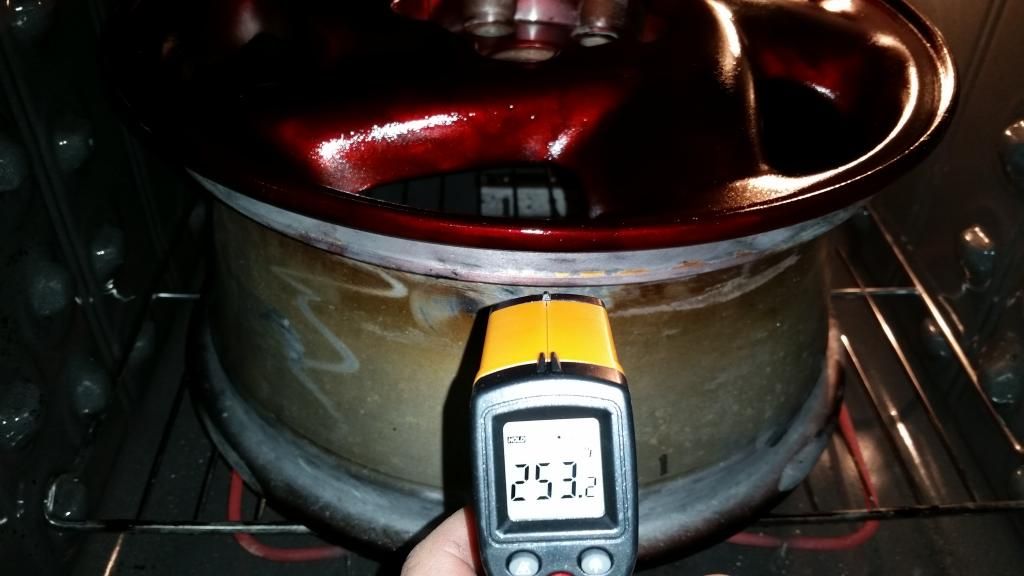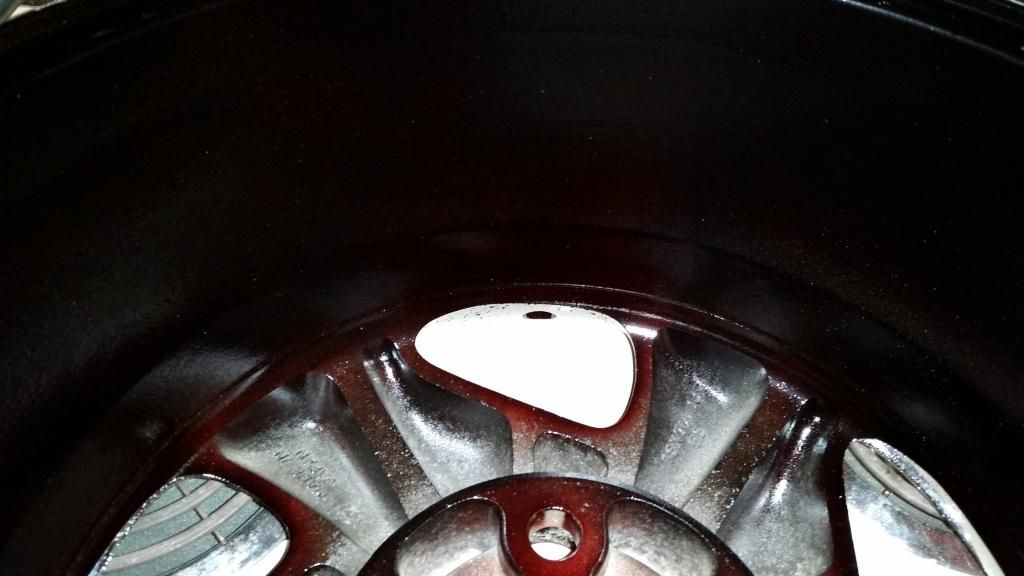It was all good up to this point, the, of course, it was time for an "oops".. I called the V.P. in to assist ( today, he's the V.P. of product improvement ). As I picked up the rim off the hanger, it was necessary to remove the copper hanger. Well, hanger is a bit of a stretch. To hang the rim, I just grabbed a length of 12/2 and stripped out the ground part. Anyway, for once he actually did what I said as soon as I said it. I said "Grab the rim"... I was about to add "from the center", but it was too late, he, of course, grabbed it from the back side. . As you may have noticed from the picture of the rim hanging, the wire passed through the center of the rim, necessitating removing it before it went in the oven. It didn't actually contact the face of the rim while being powder coated, but, unfortunately, it did contact the rim while being removed. Second "oops".
So we had the philosophical debate as to what to do about the two "oops". The solution we came up with was to sprinkle a bit of powder by hand over the affected area, and see if it spread out while baking. Along the lines of finding out what was within the tolerances of " that won't show after it's baked"..
So into the oven it goes. One of the things about powder coating is that there MUST be an electrical point of contact. If you're lucky, you can make it somewhere it won't be visible on the finished product. The other consideration is that, unless you can hang it in the oven by the same point, there will be marks from the contact points when baking. Thus the on it's back on the bottom rack for curing. That also introduces some considerations as to curing times due to the proximity to the bottom heating element. More about that later, but for now, in she goes.
So here comes the WTF factor, The oven was up to curing temp for over an hour before the rim was put in, so absolutely, the internal temperature was stable ( and verified with the gun ). Yet, with the oven door being open for less than thirty seconds, the oven started to lose temperature with the rim inside. Usually, with nothing in the oven, if the element was on, a reduction in the setting of a few degrees would result in the indicator light going off. Conversely, if the indicator light was off, raising the temperature setting a few degrees would bring the indicator light on. Four minutes after putting the rim in, the indicator light was still on, and I had to drop the setting down to about 340 F to get the indicator to go out. From that significantly less than double blind situational observational analysis, I could only conclude that twenty five pounds of cold aluminum was putting a smack down on the heating abilities of the oven. The other "dammit" factor was that it was apparent that the lower part of the rim was being blasted with the radiant heat of the element, mere inches away, while the top of the rim was not being heated properly.
As noted earlier, the actual timing of the curing process is supposed to start when the part reaches the specified curing temperature. That's fine as a concept, especially when curing smaller parts, that head up comparatively rapidly. I've done several small items, and all that I do is add two or three minutes, set the timer, and pull the item when the buzzer goes off. Small items usually show the powder starting to flow within ninety seconds, indicating that curing process has begun.
So here's the problem, the rim is way under curing temperature, but the coating is starting to flow...

Now, I'll be the first to admit that I know jack about polymers, resins, curing at lower temperatures, etc., so now I'm kinda stumped. If it says that it cures in ten minutes at 375 F, obviously, it would cure at 370 F, it would just take longer, it would cure at 350 F , but what would it take? An extra ten minutes? An extra hour?.. Once again, let down by the University of Y&G.. What I needed was a chart that said " If coated product weighs X, add X minutes for each additional pound"... Maybe such a chart exists, but if it does, I couldn't find it.
I pulled it out of the oven, and it smoked when it hit the cool air, so I stuck it back in for another ten minutes... and got this.

And on the back, with the black base with the burgundy overspray mixed in..

Not what I was aiming for, but definitely interesting..
Now what will a coat of clear do for it?